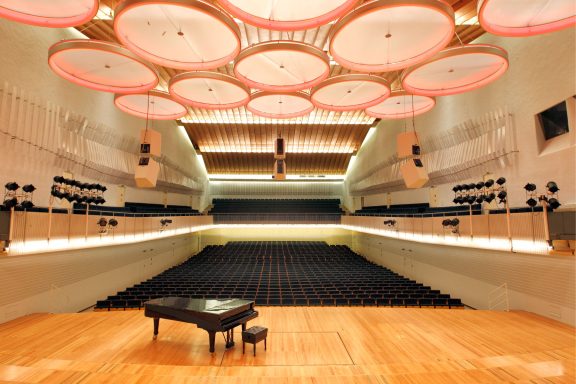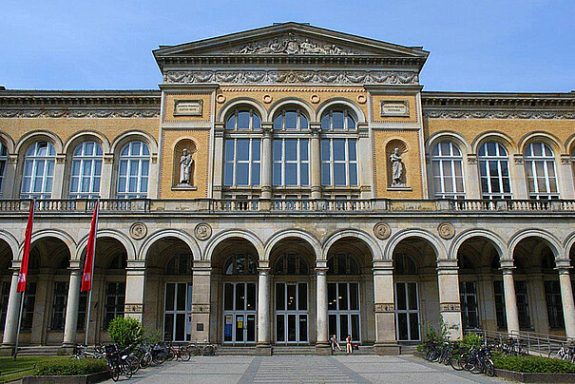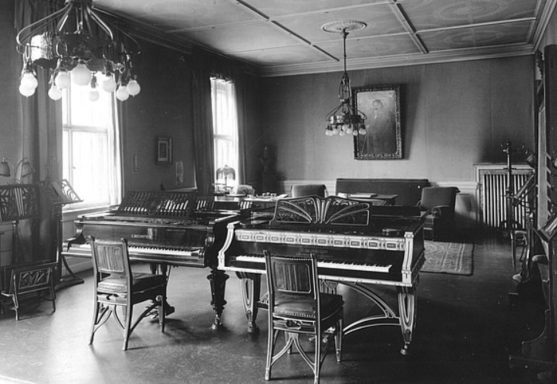This page consists of the biographies and descriptions of my piano teachers as well as the institutions that had a significant effect on my personal and artistic development listed below.
Teachers:

Prof. Sabine Simon (2024 - now)
Prof. Sabine Simon is the newly appointed German professor for piano and piano methodology at the Berlin University of the Arts, taking over in 2024 for Prof. Linde Großmann who held this position since 1992.
Similarly to my former teacher Prof. Dr. Thomas Menrath, she regards as her greatest influence the Hungarian piano professor György Sebők at India University Bloomington where she also studied with Menahem Pressler.
In Berlin, she was the pupil of two renowned German pianists in the GDR, Dieter Zechlin and Annerose Schmidt who both taught at the "Hanns Eisler" School of Music, on the East side of Berlin.
Another influence was the prominent Finnish piano professor Hans Leygraf at the Mozarteum in Salzburg, Austria.
Sabine Simon played with many leading orchestras and performed around the globe with a wide ranging repertoire and an additional focus on contemporary music.
She won the first prize at the Bach-Competition Leipzig and the Bechstein Competition, the Edvard-Grieg-Prize in Grieg Competition in Oslo and the special prize at the Chopin Competition in Darmstadt. In Darmstadt, she is now an active member at the "Chopin Gesellschaft in der Bundesrepublik Deutschland" (Chopin Society in the Federal Republic of Germany) and also taught many years at the "Akademie für Tonkunst Darmstadt" (Academy for Sound Art in Darmstadt), founded in 1851.
Since 2024, I have the pleasure to study with her simultaneously as one of the first students in her piano class and her pedagogy class. We have a lot of work planned and it is exciting to have a fresh perspective and beginning after 5 years in the piano class of my dear Thomas.

Prof. Dr. Thomas Menrath (2019-2024)
Prof. Dr. Thomas Menrath is a German piano pedagogue teaching at the Berlin University of the Arts since the early 90s.
Thomas Menrath has studied with the niece of famous piano pedagogue Heinrich Neuhaus, Astrid Schmidt-Neuhaus who published the German edition of his well-known book The Art of Piano Playing / Die Kunst des Klavierspiels / Об искусстве фортепианной игре and was a piano professor in Cologne with her husband and duo partner Hans-Otto Schmidt-Neuhaus whose pupils include Christoph Eschenbach, Karlheinz Stockhausen, Ludwig Hoffmann and Pi-hsien Chen.
Heinrich Neuhaus himself studied in Berlin at the predecessor institution of the Berlin University of the Arts with Leopold Godowsky and is regarded as one of the most important piano professors of the 20th century who has made a significant impact on many generations of the piano school in the Soviet Union.
In Berlin, the two major influences of Thomas Menrath were his Romanian piano professor Georg Sava (student György Halmos - alumni of the Budapest music academy, student of famous Liszt student Emil von Sauer and also Paul Weingarten in Vienna) and György Sebők, the renowned piano pedagogue known for his inspiring masterclasses and representing the rich Hungarian piano tradition who regularly taught Thomas Menrath as a visiting professor at the Berlin University of the Arts.
Prof. Dr. Thomas Menrath has played in a piano duet with his colleague Prof. Linde Großmann (professor for piano methodology at the Berlin University of the Arts, alumni Gnessin Institute of Music Moscow, piano class of Maria Grinberg) and published a variety of different musicological papers with a psychological perspective on piano pedagogy and interpretation and did his doctorate on the "unteachable as a methodological subject in the piano method of Carl Adolf Martienssen".
I am very grateful to have spend five years in his piano class, he has been a dear friend and role model and a very honest and humane presence that automatically provided me with the energy to build myself up on my own as an artist and also gave me enough space to develop in my aspired direction in a very important time span where I made my first steps into adulthood.

Rüdiger Mühleisen (2018-2019)
Rüdiger Mühleisen is an experienced piano teacher based in Berlin well known for preparing and developing young students to a high level. He is teaching at the music school "Fanny Hensel" and the two main music institutions in Berlin, "UdK" and "Hanns Eisler". He studied at the Berlin University of the Arts with Prof. Ingeborg Wunder, student of Richard Rössler who himself studied at the predecessor institution of the Berlin University of Arts with legendary Karl Heinrich Barth and Ernst Rudorff.
Rüdiger Mühleisen also studied with Prof. Georg Sava and therefore received a similar piano education as Prof. Dr. Thomas Menrath. He has toured extensively, made many recordings at radio stations and furthermore had unusual appearances e.g. at the well-known German TV show "Tatort" or his participation in projects with Udo Lindenberg or the heavy metal band "Knorkator".
He managed to prepare me in less than a year to the entrance exam of the pre-college for gifted students at the Berlin University of the Arts whilst doing it in the smoothest and most relaxed way possible and being a very supportive and kind person. Years later, he became my guidance once more as a professor for my first teaching attempts at university and remains an important presence in my life.

Daniel Selke (2017-2018)
Daniel Selke is a pianist and conductor who teaches at the music school of the city Potsdam "Johann Sebastian Bach" and is the artistic director of the Ernst-Busch-Choir in Berlin.
He is mostly known for his award-winning duo called CEEYS or in more recent years BRUEDER SELKE which consists of him as a pianist and various other types of keyboards and his brother Sebastian who plays mostly the Cello and with whom he grew up on the east-side of the Berlin border. The Potsdam-based duo is well established in the neoclassical international scene and has released acclaimed albums and music videos and successfully founded their own festival Q3Ambientenfest in Potsdam which brings together established and emerging artists of diverse origins and genres.
He was my first German piano teacher at a public music school after I had only experienced years of private lessons with the "three Russian ladies".
I was very inspired by his eloquent and calm attitude towards music and his wide horizon of knowledge about classical piano and beyond. He greatly encouraged to express my creativity to the full extent and to develop my individual artistic persona and not conform to the music mainstream.

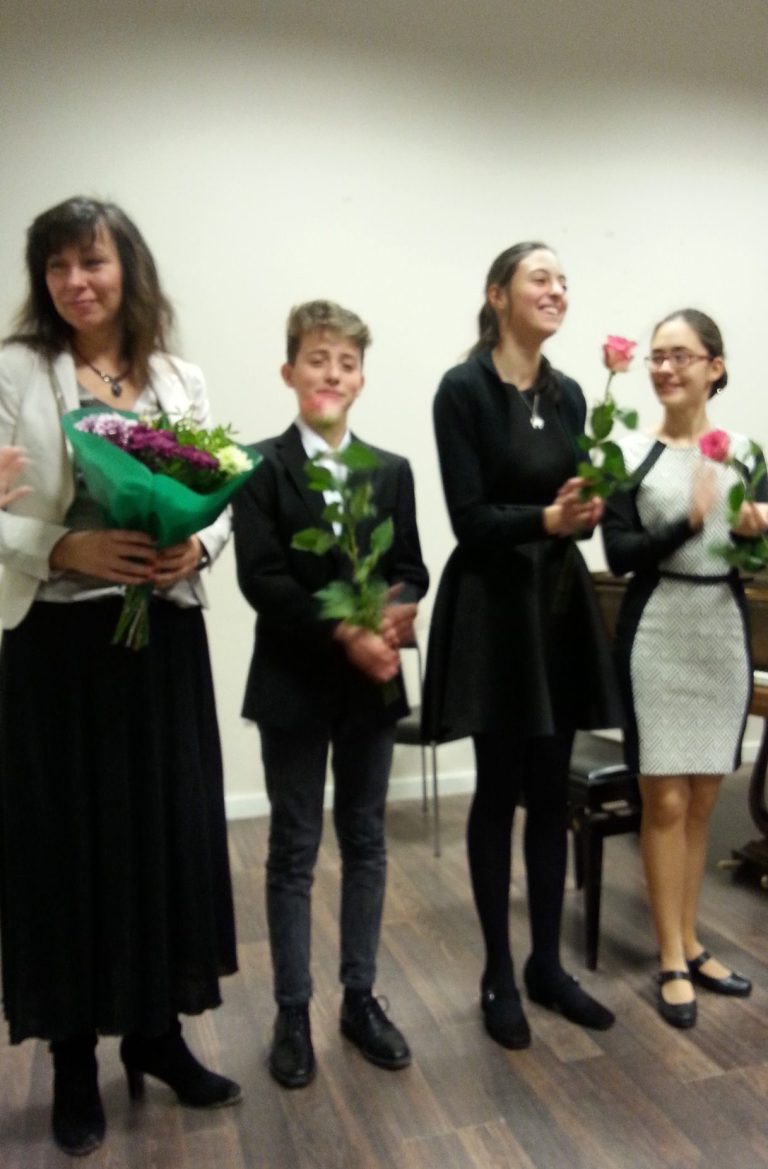
Ekaterina Tochyltseva (2016-2018)
She was the last of my private lessons with the three Russian ladies and the most demanding of them pianistically. Even though I remember her always coming about an hour late, when she did finally arrive we worked often over two or three hours intensely with careful consideration to every single phrase. It was at this time, that I simultaneously got to know the world of classical music through YouTube and have made the decision to become a pianist. She encouraged me to continue my studies at bigger institutions and prepared me for my first competition where I received the first prize and special prize. I am especially grateful that she knew when to give me into new hands and for her selfless commitment to my pianistic development. The picture is from a class concert just before my first competition success where you can see me standing next to her and her other two talented students.

Elena Karmazina (2015-2016)
I remember a very relaxed and comfortable atmosphere where we explored and sight-read a lot of the most important and beloved piano repertoire from the classical and romantic period. The pieces where quite challenging and developed the difficulty I could manage to play even though we didn't work on it in great detail and the pieces often remained a bit sloppy. From the three Russian ladies, she is the most active concert visitor and is well in touch with the current classical music industry and remains a regular companion to interesting piano recitals.
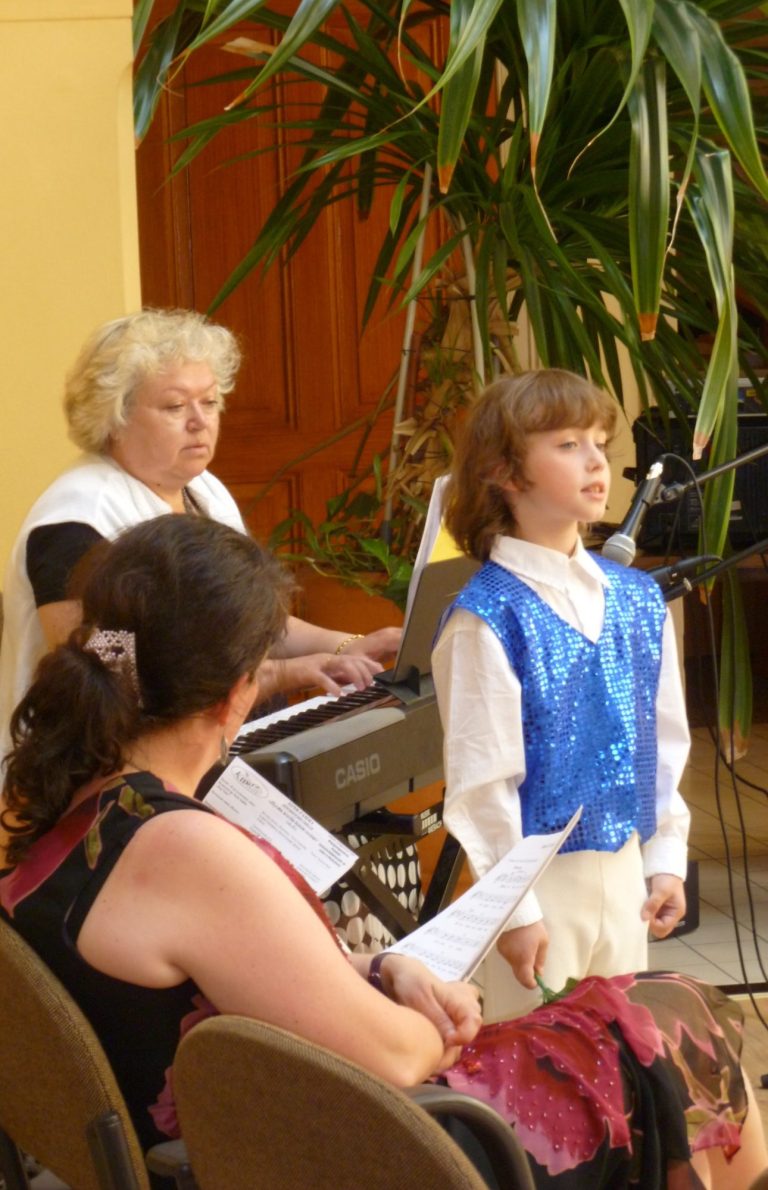
Elena Timofeevna: (2009-2015)
She was my very first music teacher from the age of 6 to 12 and layed the whole foundation to my artistic life. She studied at the Gnessin music school in Moscow and was the first prize winner of the music theatre competition of the Soviet Union. I started with singing lessons at the age of six where she quickly noticed my musical talent and committed herself to develop it to the best of her ability which included teaching me to play piano at the age of seven, regularly providing me with concert opportunities where I often performed as a solo singer as well as on the piano and encouraging me to compose my own music and teaching me how to write it down.
I unfortunately can't recall our lessons but she told me that I learned incredibly quick and effortlessly which led to a pleasant but strict lesson dynamic.
I am incredibly grateful that she combined the element of singing with piano playing which is one of the most important principles of the Russian piano school and that she also developed my stage presence and the theatrical and choreographic aspect of music making which I got to explore soon after at the Friedrichstadt-Palast Berlin as an actor, singer and dancer at their kids shows.
Institutions:
Universität der Künste Berlin (UdK) /
Berlin University of the Arts (UDK)
The Berlin University of the Arts, abbreviated as UdK for „Universität der Künste“, is the largest art school in Europe and known for being one of the most diverse artistic institution in the world with almost all of the study courses being part of a centuries-old tradition. Esteemed professors and outstanding students from all around the world have publicly defined the university as a high level of artistic and art-theoretical education.
The music faculty has a rich history that dates back to its beginnings in 1869 when violinist Joseph Joachim founded the Royal Academy of Musical Performing Arts in Berlin. Since then, the music institution attracted many of the most important musicians and has made an unique and omnipresent impact on the music world.
Pianists like Artur Rubinstein, Artur Schnabel, Wilhelm Kempff, Leopold Godowsky, Heinrich Neuhaus, Karl Heinrich Barth, Ernst von Dohnányi were part of the highly acclaimed piano faculty.
Among the professors from other music faculties were composers like Max Bruch, Paul Hindemith, Engelbert Humperdinck, Isang Yun and interpreters like Sergiu Celibidache, Carl Flesch, Emanuel Feuermann, Wanda Landowska and Dietrich Fischer-Dieskau.
Being situated in the metropolitan city Berlin which is known for being a world city of different cultures and creative industries with a very vivid music and art scene and several world-famous venues, the students have an uniquely creative and productive environment around them.
The Julius-Stern-Institute is an internationally renowned pre-college at the Berlin University of the Arts that enables a few selected young musicians of exceptional talent to receive an extensive music education on the highest level. Founded in 1850 as "Stern'sches Konservatorium" as the first independent music institution in Berlin, it quickly became a very renowned institution with alumni like Claudio Arrau, Edwin Fischer, Moritz Moszkowksi, Otto Klemperer, Bruno Walter and professors like Hans von Bülow, Martin Krause, Rudolf Maria Breithaupt, Émile Sauret, Engelbert Humperdinck and Arnold Schönberg. Due to the Nazi regime, the institute lost most of its members and never really recovered afterwards. In 1966 it became part of the Berlin University of the Arts and only since 1999 with a new director Doris-Wagner Dix and afterwards her successor Anita Rennert it is fully present in the music scene with its new purpose of developing talented young musicians.
Friedrichstadt-Palast Berlin

The Friedrichstadt-Palast is a revue theatre in the centre of Berlin, described as the biggest theatre stage in Europe. Even though I'm not entirely sure on what this is based on (I believe it refers to the squaremeters of the stage), the shows are widely known and enjoy a high reputation with high profile directors and sponsorship. The venue specializes in complex shows that use advanced lighting and stage technology, over a hundred performers, and stylized acrobatic numbers. The theatre tries to hit all the superlatives of show business and is an important establishment in Berlin's cultural scene. The trademark of the shows is the girls kickline.

Besides their main shows for adults they also have the Children and Youth Ensemble, "Children play for children," with 250 Berlin members ranging from ages 6–16. Most of them are dancers, their are only a few coveted all-in-one roles which I got casted as and which includes being an actor, singer and dancer. I took part in two shows where I had solo and duo roles before I quit to concentrate on my own music development. The training was quite intense, I often had to travel multiple times a week after school in Potsdam to Berlin and came home late in the evening. The environment, even though superficial, was warm, familiar and professional, besides demanding coaches I was also surrounded by highly artistic "classmates" who became quite famous like David Hermlin, Egon Werler and Oskar Marten.
Hermann-von-Helmholtz Gymnasium Europaschule Potsdam
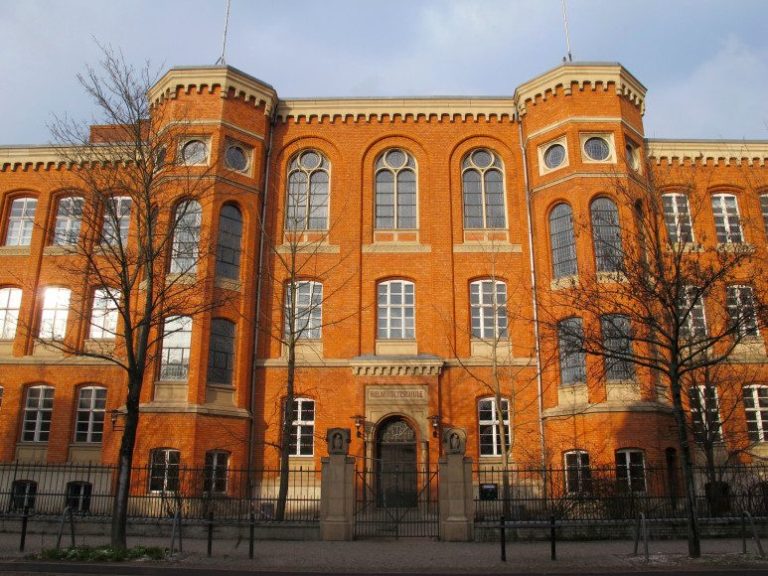
The Helmholtz-Gymnasium is known as one of the top schools in Potsdam. Founded in 1738 with a long history, many distinguished alumni like pianist Wilhelm Kempff, mathematician Carl Gustav Jacob Jacobi and even polymath Hermann von Helmholtz himself have been educated here. It is located in the centre of Potsdam and out of all schools in Potsdam it is the most music oriented even though it is still minimal in comparison to Berlin. There was an unusually high amount of 5 music pre-college students in my grade which was an interesting coincidence.
Wir benötigen Ihre Zustimmung zum Laden der Übersetzungen
Wir nutzen einen Drittanbieter-Service, um den Inhalt der Website zu übersetzen, der möglicherweise Daten über Ihre Aktivitäten sammelt. Bitte überprüfen Sie die Details in der Datenschutzerklärung und akzeptieren Sie den Dienst, um die Übersetzungen zu sehen.
